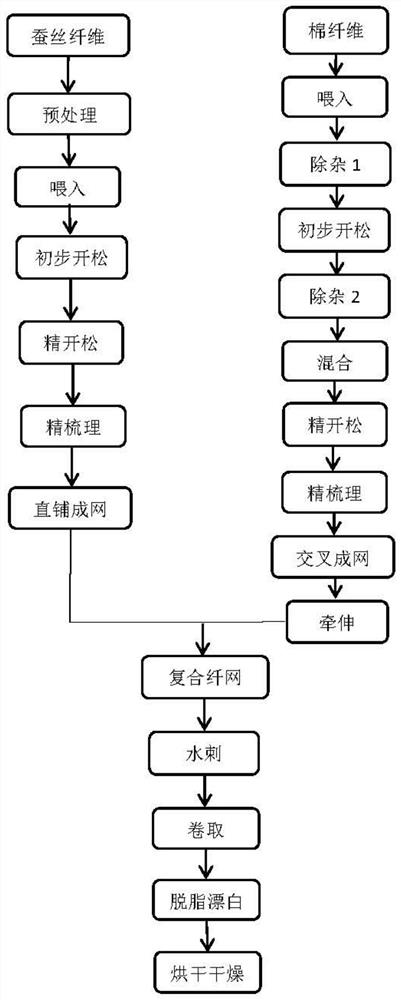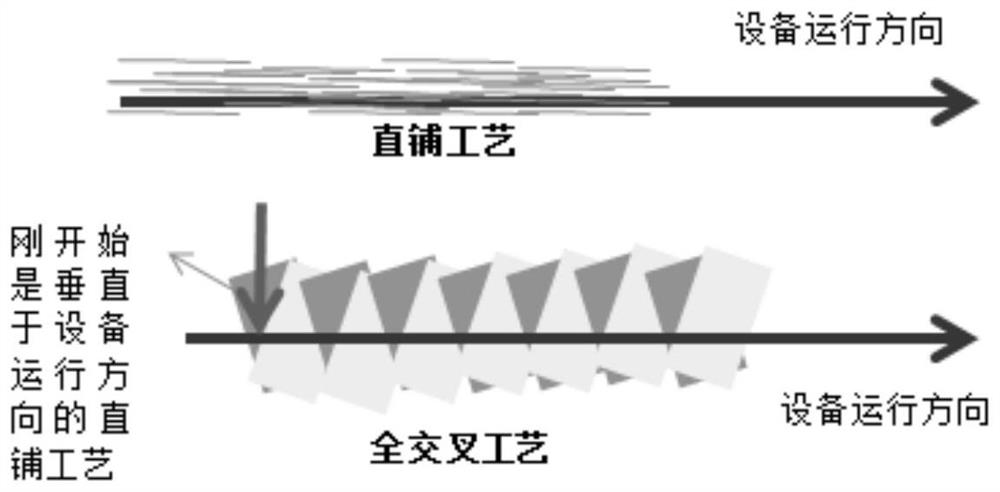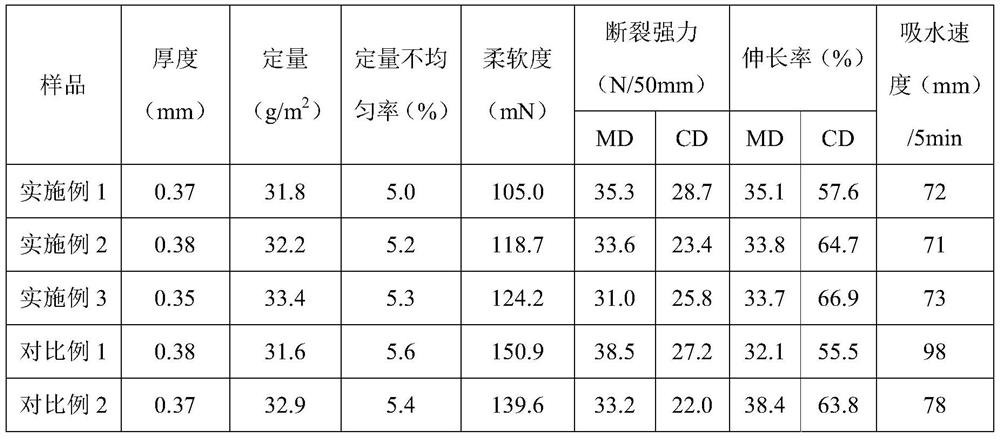A kind of preparation method of composite non-woven fabric and application thereof
A technology of non-woven fabrics and silk fibers, which is applied in the field of preparation of composite non-woven fabrics, can solve problems such as flying flowers, affecting the uniformity of fiber webs, and complicated preparation processes, so as to enhance safety and absorbency, solve side leakage of menstrual blood, Wide range of adjustable effects
- Summary
- Abstract
- Description
- Claims
- Application Information
AI Technical Summary
Problems solved by technology
Method used
Image
Examples
Embodiment 1
[0073] Embodiment 1 A kind of preparation method of composite non-woven fabric
[0074] (1) Silk fiber pretreatment
[0075] Under the conditions of ambient temperature of 25°C and humidity of 55%, spray oil on silk fibers. The main component of oil is antistatic agent (model: S10), which should be mixed according to the ratio of antistatic agent: water = 1:6. , according to the ratio of oil agent: silk fiber = 1:30, evenly sprayed on the fiber, and treated for 36 hours.
[0076] (2) Preparation of silk fiber web
[0077] Using pretreated 100% natural silk fiber, using a disc catching machine to grab and feed the silk fiber, initially open the silk fiber, and transport it to the FA106 opener by air flow for fine opening, so that the silk is further decomposed. The silk enters the ZWF1206 pre-carding machine for fine carding to make the silk into single fibers. After collection and storage, it is stored in the ZGB1026 cotton storage box. The pressure in the cotton storage box...
Embodiment 2
[0091] Embodiment 2 A kind of preparation method of composite non-woven fabric
[0092] (1) Silk fiber pretreatment
[0093] Under the conditions of ambient temperature of 22°C and humidity of 52%, spray oil on silk fibers. The main component of oil is antistatic agent (model: S10), which should be mixed according to the ratio of antistatic agent: water = 1:3. , according to the ratio of oil agent: silk fiber = 1:20, evenly sprayed on the fiber, and treated for 24 hours.
[0094] (2) Preparation of silk fiber web
[0095] Using pretreated 100% natural silk fiber, using a disc catching machine to grab and feed the silk fiber, initially open the silk fiber, and transport it to the FA106 opener by air flow for fine opening, so that the silk is further decomposed. The silk enters the ZWF1206 pre-carding machine for fine carding to make the silk into single fibers. After collection and storage, it is stored in the ZGB1026 cotton storage box. The pressure in the cotton storage box...
Embodiment 3
[0110] Embodiment 3 A kind of preparation method of composite non-woven fabric
[0111] (1) Silk fiber pretreatment
[0112] Under the conditions of ambient temperature of 28°C and humidity of 60%, spray oil on silk fibers. The main component of oil is antistatic agent (model: S10), which should be mixed according to the ratio of antistatic agent: water = 1:10. , according to the ratio of oil agent: silk fiber = 1:100, evenly sprayed on the fiber, and treated for 48 hours.
[0113] (2) Preparation of silk fiber web
[0114] Using pretreated 100% natural silk fiber, using a disc catching machine to grab and feed the silk fiber, initially open the silk fiber, and transport it to the FA106 opener by air flow for fine opening, so that the silk is further decomposed. The silk enters the ZWF1206 pre-carding machine for fine and fine carding to make the silk into single fibers. After collection and storage, it is stored in the ZGB1026 cotton storage box. The pressure in the cotton ...
PUM
| Property | Measurement | Unit |
|---|---|---|
| length | aaaaa | aaaaa |
| Basis weight | aaaaa | aaaaa |
| Basis weight | aaaaa | aaaaa |
Abstract
Description
Claims
Application Information
 Login to View More
Login to View More - R&D
- Intellectual Property
- Life Sciences
- Materials
- Tech Scout
- Unparalleled Data Quality
- Higher Quality Content
- 60% Fewer Hallucinations
Browse by: Latest US Patents, China's latest patents, Technical Efficacy Thesaurus, Application Domain, Technology Topic, Popular Technical Reports.
© 2025 PatSnap. All rights reserved.Legal|Privacy policy|Modern Slavery Act Transparency Statement|Sitemap|About US| Contact US: help@patsnap.com



